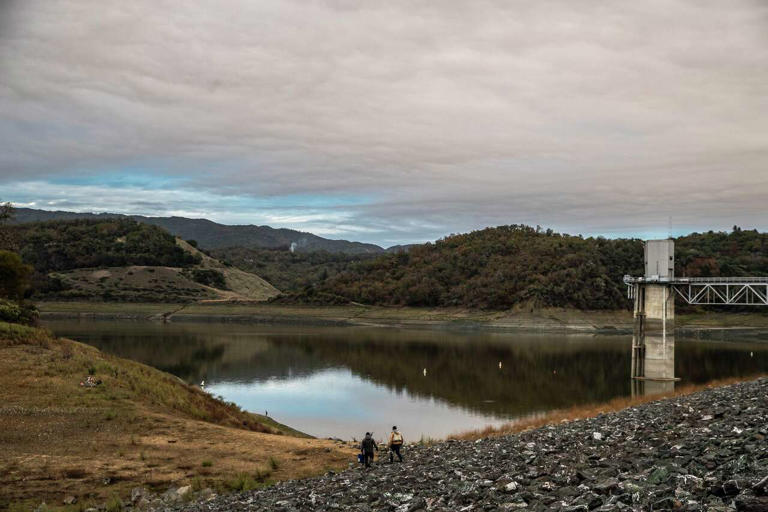This Northern California reservoir has pioneered a way to store more water
Story by Kurtis Alexander
• 5h

Fishermen descend a berm to fish in a severely depleted Lake Mendocino in Ukiah, in 2021. The reservoir has implemented a new way of forecasting that will allow it to hold more water. (Stephen Lam/The Chronicle)
A decade ago, when one of California's worst droughts almost dried up Lake Mendocino, dam operators at the reservoir 125 miles north of San Francisco faced criticism for not storing more water in rainier times.
But it was hardly their fault. The amount of water held and released at the reservoir, which serves Mendocino, Sonoma and Marin counties, had been dictated by old, rigid federal rules for reservoirs, to make sure they keep enough empty space for capturing floodwaters.

This week, after years of advocacy and experimentation, officials at Lake Mendocino will celebrate the reservoir's status as the first reservoir in the nation to get the go-ahead to adopt a flexible, forecast-based operations policy. The lake's new water control manual, reliant on modern-day weather models, and notably an understanding of atmospheric rivers, gives dam managers the ability to stash additional water, which could boost reserves sometimes 20% or more when the conditions are right.
Technically known as Forecast Improved Reservoir Operations, or FIRO, the management strategy pioneered at the lake is already being tested at other reservoirs in California and beyond, including giant Lake Oroville. The hope is that greater adoption of the practice will widely increase water supplies, while also balancing flood risk, as extreme weather events become more frequent with climate change.
"This concept was really foreign to the way of doing business," said Don Seymour, deputy director of engineering in resource planning at Sonoma Water, the regional water provider that helps manage Lake Mendocino. "The thought was: could we start using forecasts instead of water on the ground (to manage reservoirs), and could we store more water rather than release it?"
While the idea may seem obvious, weather and water forecasting are far from perfect. To take a chance on any unforeseen conditions could have grave consequences. For example, an unexpected storm could force dam managers to discharge too much water and cause downstream flooding.
To ensure safety, the U.S. Army Corps of Engineers reservoir rules, which apply to many state and federal facilities, offer conservative direction for retaining and releasing supplies based largely on the time of year and how full the reservoir is.

Because of recent advances in projecting weather and monitoring watersheds, however, a team of dam engineers and climate experts began working to develop a strategy for Lake Mendocino in which decisions about water management could be made in real time and in concert with the latest forecasts. If the forecast showed no precipitation in late spring, dam managers could opt to hold more water for the dry summer months. Conversely, a big storm on the horizon could prompt earlier water releases.
"I had a picture in my mind, as I started researching atmospheric river storms, that there was quite a bit of prediction skill on the West Coast," said Marty Ralph, a research meteorologist and founding director of UC San Diego's Scripps Institution of Oceanography Center of Western Weather and Water Extremes, who was involved in the effort at Lake Mendocino. "(But) we needed to figure out quantitatively how this would work."

By using advanced weather models and custom forecast tools - much of the work centered on atmospheric rivers since they can account for 50% of California's precipitation - Ralph and the others came up with new guidelines for managing the reservoir.
Dam managers at the Army Corps, which runs the lake in coordination with Sonoma Water, began testing the novel approach in 2019, and by 2020, they reported a 20% increase in water storage, the equivalent of what 22,000 households used.
The Army Corps proceeded to give dam managers at the reservoir temporary approvals for employing the forecast-based strategy.
On Wednesday, those involved in developing the policy, which also include the National Oceanic and Atmospheric Administration and California Department of Water Resources, are scheduled to commemorate the signing of a new, more permanent water control manual for Lake Mendocino and its Coyote Valley Dam.
"Before this update, we would inevitably be required to release water to give airspace to the dam for the next storm regardless of the upcoming weather," said Nick Malasavage, a division chief for the U.S. Army Corps' San Francisco District, in a statement. "FIRO allows us to be informed by the forecast and make better decisions."
Lake Sonoma, which is also run by the Army Corps in coordination with Sonoma Water in the Russian River watershed, has begun testing forecast-based management with the goal of similarly changing the operations manual.
Department of Water Resources Director Karla Nemeth called the more flexible policy "critical to preparing for California's hotter and drier future." |





